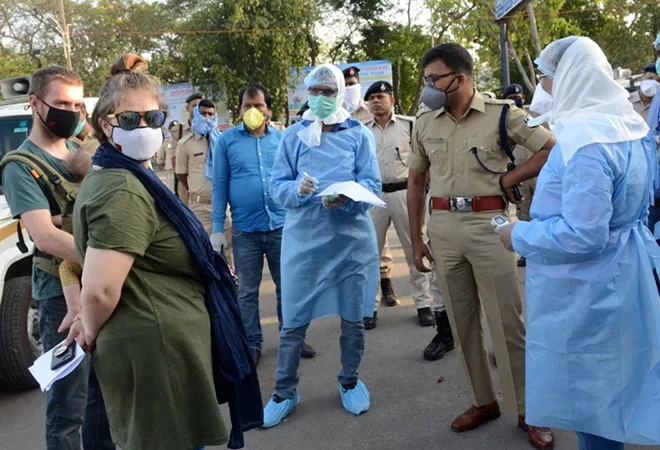
The outbreak of infectious diseases has long posed a threat to domestic and international trade and commerce. The cholera epidemics that ravaged Europe in 1830 and 1847 made a strong case for mobilising international public health response, primarily with the intent of safeguarding economic interests. Consequently, the International Sanitary Regulations laid down measures for quarantine and eventually led to the creation of the International Health Regulations (IHR) to ensure global health security. Having failed to contain SARS in 2003, the scope of the IHR was enhanced in 2005. This, however, hasn’t prevented pandemics like the H1N1 influenza, Ebola in West Africa or Covid-19, bringing forth the vulnerability of our health systems even with an international regulatory framework in place.
Post Covid-19, when normalcy sets in, health security will become a key constituent of national security. Countries may even securitise health to safeguard their economic interests from future crises. Now that the intrinsic linkages between health security and economic development are so evident, there is an inescapable need to create resilient systems to mount a pandemic response strategy. India appears to be better positioned in its battle against Covid-19 with relatively manageable infection figures under the circumstances — as of 19 April, India had 15,715 confirmed cases and a death toll of 507. But according to Dr Jacob John, former head of ICMR’s Centre for Advanced Research in Virology, India’s healthcare infrastructure is likely to be overwhelmed pretty soon.
During the 2014 Ebola outbreak, former US President Barack Obama had exhorted the need to make more investments in healthcare to tackle the next airborne viral infection. Public health security threats have pan-sectoral ramifications, which is why India needs to be better prepared to deal with such crises in the future, given that a recurrence is almost certain.
Capacity building
The Indian government’s sub-optimal response to Covid-19 highlights gaping holes in our healthcare infrastructure. India spends a measly 1.28 percent of its GDP on health, there is just one bed per 1844 patients in government hospitals, and the doctor-patient ratio is 1:1445, far from the WHO recommended one doctor per 1000 patients.
There is an urgent need to make sizeable allocations to the annual health budget to build capacities to allow for a rapid response to a public health emergency. Areas that require focus include the creation of hospitals; the creation of reserves of personal protective equipment, testing kits and masks; enhancing the supply chain of critical health related products; scaling up testing abilities of labs across the country; and strengthening R&D for therapeutics and vaccine development. While ‘flattening the curve’ through social distancing and hygiene has been at the forefront of all government initiatives, we must also ‘raise the bar’ by enhancing the capacity of healthcare systems.
It would also be prudent to temporarily re-roster retired medical professionals to prevent the existing healthcare infrastructure from becoming overwhelmed, as has been done in other countries. The Indian government needs to maintain such a roster, should the need arise in future.
Public private partnership
According to the 2017-18 National Sample Survey on household social consumption related to health, private hospitals accounted for 55 percent of all in-patient hospitalisation (52 percent in rural and 61 percent in urban areas). Given the ever-increasing demand for healthcare resources, the government needs to strengthen medical infrastructure through private sector partnerships. The Ayushman Bharat Pradhan Mantri Jan Arogya Yojana has already laid down the blueprint for such an engagement. Pooling in resources of private sector healthcare establishments would obviate the possibility of overstretching precariously positioned healthcare infrastructure in India, especially when dealing with a public health emergency.
In addition, the government must also partner with major private players, including grassroots NGOs, and utilise their network to reach out to widespread and underserved geographies.
Community-level preparedness
The government should utilise the existing service delivery model at the local level, from districts downwards to wards and villages, in its pandemic response.
Decentralised governance through devolution of powers to the local village councils to micromanage sub-centres and primary health centres would bring in ownership and accountability. Government pandemic response measures such as lockdowns and social distancing can be better implemented by involving villages. Kerala has been exemplary in its fight against Covid-19 through community level preparedness.
Rapid response teams
Outbreaks are an inevitable threat of nature. They will continue to emerge and re-emerge unpredictably. An outbreak in one part of the country is often just a plane/train ride away from another, and it is necessary that they are contained speedily. Rapidly deployable surveillance teams — comprising epidemiologists, public health experts, virologists and frontline health workers — that can gather epidemiological evidence from the ground can help arrest the spread the transmission of the virus. When employed expeditiously, such specialised teams can jumpstart containment efforts. Controlling a pandemic is easier through early prevention rather than later intervention.
Leveraging technology
Employing AI and Big Data analytics to accurately predict the likely extent of spread of a virus outbreak has a host of benefits. The government must foster innovation and engage with tech firms to scale up disease surveillance capabilities and other tech-based health solutions. This will provide much-needed early warning as well as valuable inputs for a swift response.
Robotics and wearable technologies can be gainfully utilised for screening and diagnostics in hospitals and labs to reduce the exposure of doctors and healthcare workers to deadly pathogens. These can also be utilised to disinfect public places like metro stations, airports and malls. Drones can be used for the surveillance of crowded places and the delivery of critical medical supplies. The government’s Aarogya Setu app, developed to track Covid-19 infected patients, is a step in the right direction, despite the privacy concerns.
Empowering NITI Aayog for public health emergency
NITI Aayog should be central to rendering an effective response to a public health emergency with its health and nutrition vertical regrouped and suitably staffed for multi-sectoral coordination. It would not only undertake agenda-setting and policy recommendations for pandemic response but also ensure a strict compliance through real time and measurable actions.
During 2018-2019, the health and nutrition vertical began working on the development of a public health cadre at the central and state level. A model developed on the public-private partnership mode needs to be created under this vertical to build a robust response strategy to deal with a public health emergency.
Health security, a key national security component
With over 2.3 million confirmed Covid-19 cases and a death toll exceeding 160,000 globally, health security will likely be one of the central themes in the creation of a national security framework in many countries going forward.
A pandemic response strategy is essential to ensuring health security. India is precariously placed in its fight against Covid-19 and its response after the lockdown ends will decide the trajectory of Covid-19 transmission in the country. There is a need to craft a robust and inclusive health response system, employing an entire-government approach. The government should lay greater emphasis on enhancing healthcare capacities, epidemiological surveillance and utilisation of digital health technologies. It must also encourage community-level readiness and integrated response from all stakeholders to build the resilience needed to address future health emergencies.
The views expressed above belong to the author(s). ORF research and analyses now available on Telegram! Click here to access our curated content — blogs, longforms and interviews.




 PREV
PREV


